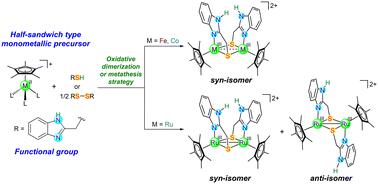当前位置:
X-MOL 学术
›
Dalton Trans.
›
论文详情
Our official English website, www.x-mol.net, welcomes your
feedback! (Note: you will need to create a separate account there.)
A new family of thiolate-bridged bimetallic complexes featuring a benzimidazole moiety: synthesis, structure and redox reactivity
Dalton Transactions ( IF 3.5 ) Pub Date : 2024-11-04 , DOI: 10.1039/d4dt02484b Kai Di, Dawei Yang, Linan Su, Ronghuan Du, Shengbin Dong, Baomin Wang, Jingping Qu
Dalton Transactions ( IF 3.5 ) Pub Date : 2024-11-04 , DOI: 10.1039/d4dt02484b Kai Di, Dawei Yang, Linan Su, Ronghuan Du, Shengbin Dong, Baomin Wang, Jingping Qu

|
Thiolate-bridged bimetallic complexes have attracted considerable attention owing to their extensive applications in bioinspired catalysis as biological metalloenzymes. Compared with bimetallic complexes supported by common thiolate ligands, those featuring functional groups that may adopt different patterns to coordinate to the metal centers are usually difficult to access, limiting their exploration. The benzimidazole moiety is a multi-faceted functional group; for example, it can act as a biomolecule-responsive ligand for the development of transition metal complexes with anticancer and antitumor properties. However, so far, there has been no report on thiolate-bridged bimetallic complexes featuring a benzimidazole moiety as the functional group. In this work, we use half-sandwich type monometallic (iron, cobalt or ruthenium) complexes as precursors to synthesize a series of thiolate-bridged bimetallic complexes via reactions with benzimidazolylmethyl disulfide (bzmds) and benzimidazol-2-ylmethanethiol (bzmt). X-ray crystallographic analyses show that diiron and dicobalt complexes feature two bzmt ligands in a syn configuration, which are bridged to the two MIII centers through the sulfur and nitrogen atoms. In contrast, the diruthenium complex possesses syn- and anti-configuration isomers in both solution- and solid-state, and the corresponding ratio of the two isomers varies upon employing different solvents. Electrochemical studies reveal that these complexes possess two or more redox couples. In particular, an FeIIIFeIII complex can undergo one-electron reduction to give an isolable FeIIFeIII species. In addition, we investigated their electronic structures by UV/vis spectroscopy and density functional theory (DFT).
中文翻译:

具有苯并咪唑部分的硫酸盐桥式双金属配合物的新家族:合成、结构和氧化还原反应性
硫酸盐桥式双金属配合物因其作为生物金属酶在生物启发催化中的广泛应用而引起了相当大的关注。与共同硫酸盐配体支持的双金属配合物相比,那些具有可能采用不同模式与金属中心配位的官能团的配合物通常难以接近,从而限制了它们的探索。苯并咪唑部分是一个多面官能团;例如,它可以作为生物分子响应配体,用于开发具有抗癌和抗肿瘤特性的过渡金属络合物。然而,到目前为止,还没有关于以苯并咪唑部分为官能团的硫酸盐桥式双金属配合物的报道。在这项工作中,我们使用半夹心型单金属(铁、钴或钌)配合物作为前驱体,通过与苯并咪唑基甲基二硫化物 (bzmds) 和苯并咪唑-2-基甲硫醇 (bzmt) 反应合成一系列硫代桥式双金属配合物。X 射线晶体学分析表明,二铁和二硼酸盐复合物具有两个 syn 构型的 bzmt 配体,它们通过硫原子和氮原子桥接到两个 MIII 中心。相比之下,二钌配合物在溶液态和固态中都具有同构型和反构型异构体,并且两种异构体的相应比例因使用不同的溶剂而异。电化学研究表明,这些复合物具有两个或多个氧化还原对。特别是,FeIIIFeIII 络合物可以经过单电子还原,得到可分离的 FeIIFeIII 物质。 此外,我们还通过 UV/vis 光谱和密度泛函理论 (DFT) 研究了它们的电子结构。
更新日期:2024-11-05
中文翻译:

具有苯并咪唑部分的硫酸盐桥式双金属配合物的新家族:合成、结构和氧化还原反应性
硫酸盐桥式双金属配合物因其作为生物金属酶在生物启发催化中的广泛应用而引起了相当大的关注。与共同硫酸盐配体支持的双金属配合物相比,那些具有可能采用不同模式与金属中心配位的官能团的配合物通常难以接近,从而限制了它们的探索。苯并咪唑部分是一个多面官能团;例如,它可以作为生物分子响应配体,用于开发具有抗癌和抗肿瘤特性的过渡金属络合物。然而,到目前为止,还没有关于以苯并咪唑部分为官能团的硫酸盐桥式双金属配合物的报道。在这项工作中,我们使用半夹心型单金属(铁、钴或钌)配合物作为前驱体,通过与苯并咪唑基甲基二硫化物 (bzmds) 和苯并咪唑-2-基甲硫醇 (bzmt) 反应合成一系列硫代桥式双金属配合物。X 射线晶体学分析表明,二铁和二硼酸盐复合物具有两个 syn 构型的 bzmt 配体,它们通过硫原子和氮原子桥接到两个 MIII 中心。相比之下,二钌配合物在溶液态和固态中都具有同构型和反构型异构体,并且两种异构体的相应比例因使用不同的溶剂而异。电化学研究表明,这些复合物具有两个或多个氧化还原对。特别是,FeIIIFeIII 络合物可以经过单电子还原,得到可分离的 FeIIFeIII 物质。 此外,我们还通过 UV/vis 光谱和密度泛函理论 (DFT) 研究了它们的电子结构。


















































 京公网安备 11010802027423号
京公网安备 11010802027423号